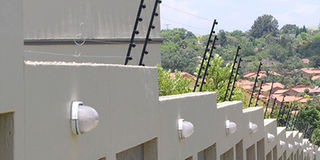Guide to installing an electric fence

Electric fencing is an effective security solution. PHOTO/COURTESY
What you need to know:
When you have chosen the equipment required, installing electric fencing is not difficult but there are a few simple but critical areas to keep in mind.
Due to insecurity in several areas across the country, it is paramount that one secures their property and lives. Many home owners have opted for different means of security and one of them is having electric fence. This system needs guidance while installing to avoid accidents which may occur after installation.
Mr. Mark Walugembe, an engineer says that installing a fence requires a combination of quality materials, use of proper construction techniques, and some push grease.
Today we are discussing on the basic steps to have a successful installation of electric fence.
Fence charger installation
Mr Walugembe says the first step is installing an electric fence charger in a clean, sheltered location away from direct moisture and sunlight with the exception of solar powered chargers. It should be accessible to a separate ground rod system from a home or shed.
“Before installing the electric charger you have to make sure that the location is close to the power source and the electric fence as possible. Even though the charger’s enclosure is basically weatherproof, it is advisable to install it indoors or in weatherproof housing so that water and direct sunshine cannot access it,” he says
Mr Walugembe adds that you have to install ceramic tube-type insulators in the walls of buildings or housings where the fence wires feed through. Frequently inspect the area where the charger is installed and maintain it as a clean and dry environment.
“Every fence charger comes with a detailed installation manual that’s why it’s necessary to hire an expert to avoid mistakes. This manual helps to assist the installer while assembling the electric fence,” he says, adding that while installing the electric fence you have to mount the fence charger off the ground using a screw or nail. Connect the ground wire to the ground terminal and ground rods using insulated ground wire.
Proper Voltage
Mr Walugembe says there must be a voltage tester which can also help to determine if there is adequate voltage on the fence line. Voltage testers are also useful in troubleshooting bad grounds and fence shorts.
“You have to make sure that you purchase a voltage tester designed specifically for electric fence. Fence testers contain special electrical system which allows the device to withstand and respond to very high voltages which are on for only a few second. Standard voltage meters used for household electrical purposes are not capable of this and will not work with electric fences because they are weak,” he says
According to Mr Walugembe, it’s important to note that voltage testers designed to read direct current pulses cannot work with alternating current fence chargers. In general most fence testers can be used with both high and low-impedance fence systems.
“If possible you can place more than one fence tester to help keep a fence system working properly. Some designs come with testing probes, while others have the probe built into the main body of the device. The simplest models feature a light, which indicates electrical current is flowing through the fence,” he says.
Grounding tips
One has to follow the instructions for grounding in the fence charger. One terminal of the charger has to connect to the fence while the other terminal has to connect to earth ground wire.
“Longer fences or areas where the soil is dry, rocky, or sandy may require more grounding rods. Multiple rods should be placed at least 10 feet apart and at least 50 feet from any other grounding system. Each rod will then need to be connected using insulated wire,” he says
Walugembe adds that grounding rods may be made of copper because copper transports the electrical charge more efficiently than the galvanized rod.
Lightning and power surge protection
Mr Walugembe says lightning is often the cause of fence charger failure. When lightning strikes the fence, the sudden power surge can travel down the fence wire and damage the fence charger.
“To prolong the life of a fence charger, consider disconnecting the fence charger from the power source before or during storms. Install a lightning diverter to distract lightning to the earth before it can damage the charger,” he says.
For greater protection, install one lightning diverter each corner of the fence, but not closer than 50 feet to the fence charger and then use a lightning choke between the fence line and fence charger to dissipate power surges caused by lightning.
TYPES OF ELECTRIC FENCES
Piggyback
A Piggyback electric fence is mounted off the back of an existing wire or mesh fence, adding another level of security to the existing perimeter barrier. The piggyback profile is fastened to existing fence posts (e.g. pillars of a palisade fence) using rivets or screws. These are the most commonly used security electric fences.
Wall top
Wall-top electric fences attach to the top of an existing perimeter barrier such as a masonry wall. These are the second most common type of security electric fences. The existing fence must be at least 1 1⁄2 metres (4 ft. 11 in) high.
Stand-alone
Stand-alone electric fences act as the sole perimeter barrier. They are also quite aesthetically pleasing if set up neatly. This type is normally only found at one of many levels of perimeter security around high-security establishments, meaning that to touch it someone has had to break through at least one physical barrier before this. The stand-alone fence must be at least 1 m (3 ft 3 in) away from the nearest barrier.




